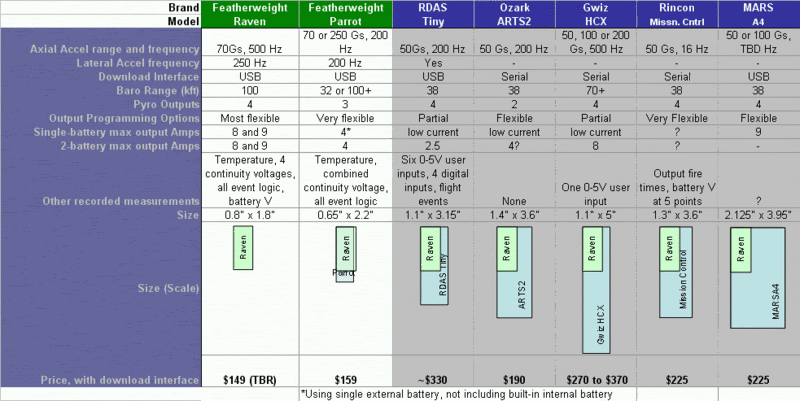...is now available.

After months of alpha testing and a successful round 1 of beta testing, I have the first production batch of Ravens just about done. Since the first round of beta testing, I have added a lot of features, and there have been major updates to the user's manual and Featherweight Interface Program, so you should consider these first altimeters as Raven Beta test round 2. They're discounted $10 off, available for only $139.
Highlights:
-Only 1.75" long and 0.8" wide
-4 high-current, programmable outputs
-Digital-output baro sensor is super accurate up to 100,000 feet and over a wide range of temperatures
-70g axial accel recorded at 500 Hz
-35g lateral accel recorded at 23 Hz
-All 4 continuity voltages recorded at 23 Hz throughout the flight
-Deployment current recorded at 46 Hz
-Professionally-written, GUI-based interface program
-On-board flight simulation for ground testing
-Operates either end up
-Apogee beeped out after the flight, based on a sophisticated apogee detection algorithm that is insensitive to deployment transients
Comparison to other full-featured altimeters:

For more info and to place an order, go to
http://www.featherweightaltimeters.com/The_Raven.php
Thanks
-Adrian
I still haven't figured out all I can do with the Parrot yet and I want one already. Are they calibrated to NIST-traceable standards?
Warren
I still haven't figured out all I can do with the Parrot yet and I want one already. Are they calibrated to NIST-traceable standards?
Warren
Thanks Warren. Yes, the sensor is is calibrated at the chip factory, and since it has the whole analog chain included on the chip, there aren't any other error sources that could come from the rest of the board to affect the readings. It is basically the same sensor you wrote about earlier, with the same error curves.
I flew 5 of them together in a big Bertha earlier this summer, and I was happy to find that the recorded altitude from all 5 was right on top of each other throughout the flight.
Very nice.
Can't wait for Saturday..... E-bay is sitting waiting for it to arrive....
Can't wait for Saturday..... E-bay is sitting waiting for it to arrive....
I'll have a bunch of Ravens with me all boxed up and ready to go. Now will I have my BALLS sustainer fixed up for an altitude attempt? We'll see. Might depend on how much sleep I want to get on Friday.
Can't wait for Saturday..... E-bay is sitting waiting for it to arrive....
I'll have a bunch of Ravens with me all boxed up and ready to go. Now will I have my BALLS sustainer fixed up for an altitude attempt? We'll see. Might depend on how much sleep I want to get on Friday.
So did it get mailed out this week or are you bringing it with you? I got the email from paypay that it was mailed monday. I may have to come to work tomorrow if it doesn't come today.
Thanks to John Wilke's helpful redlines, I updated the Raven's user manual. It's available here:
http://www.featherweightaltimeters.com/uploads/Raven_Users_Manual_09Nov8.pdf
Raven link:
http://www.featherweightaltimeters.com/The_Raven.php
What really happened is I said "Adrian, I'm a bit of an idiot on electronics sometimes and I need you to essplain some of this stuff to me" 😀 In all sincerity, thanks for spending some time with me on it. I was amazed to see how small it was... I knew it would be, but seeing it was nonetheless enlightening. It isn't much bigger than a postage stamp....
See what happens when an English major get his hands on a paper... I'm glad you made this up Adrian. Geologists can only be tech savvy to a point - as you saw earlier. 😳
Had to add this in now that I have been able to check it out.
WOW! I like it. It's so easy to use and understand, plus, this thing does all kinds of cool things. I really like having 4 channels. I can foresee more in my inventory.
I'm still trying to figure out how to unlock my car doors with it, there has to be a function in it somewhere.... 😆
Oh yeah, mine's even in your picture - good ol #30
Adrain, Thanks for all the hands on information for the Raven.
So, is the difference between the choices, 250 G singal axis, or 70 G dual axis?
besides 180 G's?
Wow, is that even possible 250 G's model rocket?
Thanks
David
The 70G version has a lateral accel axis also. I recommend the 70G version because the axial accel has better resolution and can be calibrated more accurately. The lateral G information is sometimes interesting also, for things like seeing how many times your rocket bounced around in the launch rail, and how long it was oscillating from weathercocking.
You have to try pretty hard in order to get a rocket to go past 70 Gs under thrust. For example, my I600 shots last summer took off pretty fast, but they had about 60 Gs.
http://www.youtube.com/watch?v=LLcz4YLPTHY
The most I have seen is 125 Gs on a cut-down thunderbolt 38 flying an H999. An I1200 in a light rocket could exceed 200 Gs, though. So get a 250G version if you're going for a max acceleration flight on a Warp-9 or maybe a CTI Vmax load, but otherwise get the 70G version.
Also, deployment charges, especially in small rockets, can make your av-bay go past 80 Gs, but that's o.k. The accels of both types can take 1000+Gs without damage.


